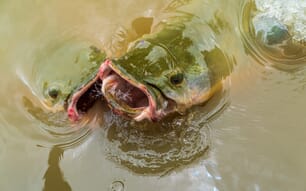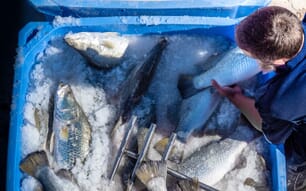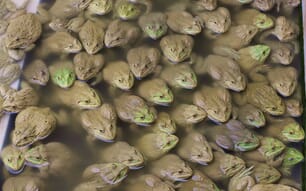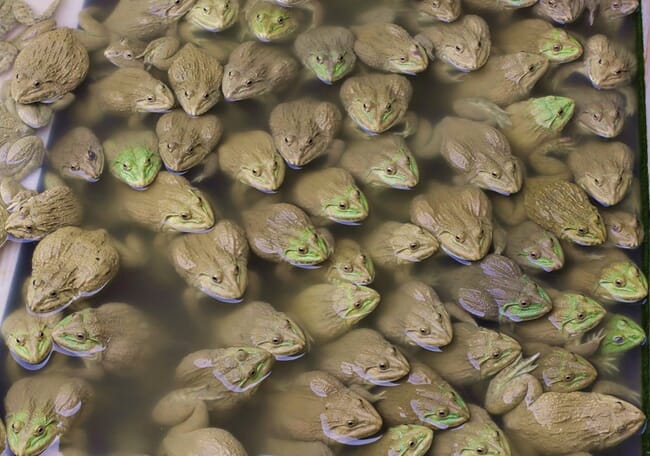
© Greg Lutz
It would seem that frog farming may finally be coming into its own after many decades of little commercial progress. Frogs are cold-blooded animals, so their culture is generally limited to tropical and sub-tropical regions, but farming activities have been increasing rapidly in many parts of the world. This is generally a sign of efficient and profitable technology and management practices, in spite of some recent investment trends in other aquaculture sectors.
Nonetheless, land costs, labour costs, prevailing climatic conditions and value chains all impact the economic feasibility of frog farming, as does competition from poorly regulated harvests of wild frogs. There are two phases involved in frog culture – larval rearing to metamorphosis, followed by grow-out to marketable size. Both have significant management issues to contend with, including diseases, cannibalism, nutrition, water quality and sanitation/biosecurity.
Native vs introduced species
While frog farming has long been pursued in many countries and with a number of species, most of the early research and development efforts focused on the American bullfrog (Lithobates catesbeianus). This species, native to North America, often reaches 20 cm in length with large females laying up to 25,000 eggs at a time. These seemed like ideal characteristics for a cultivated species when research trials began in earnest, but feeding soon emerged as a major problem because many frog species, including the American bullfrog, will only feed on live food (or whatever they perceive to possibly be alive). Early research using live foods for L. catesbeianus typically resulted in feed conversions of 2.8 to 1, and occasionally higher. Eventually, researchers and producers realised that, if they could cause feed pellets to move around in front of the frogs’ noses by using bubbles, flowing water or motorised feeding trays, they could fool them into consuming it. Sometimes.
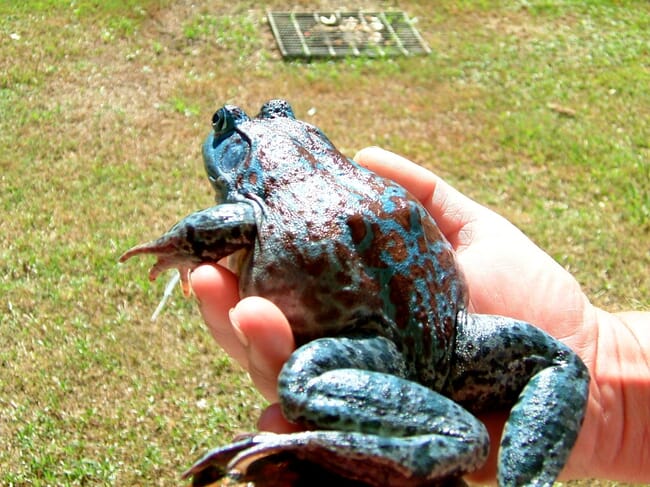
© Greg Lutz
The American bullfrog was widely introduced to distant lands over the last century, primarily with an eye toward farming or as a substitute for smaller native species. It is now found in more than 40 countries, and is being cultured primarily in South America and Asia. Nonetheless, many governments, researchers and entrepreneurs across the world have focused on developing culture techniques for native frog species. Some examples include: the marsh frog (Pelophylax ridibundus) in Europe, where farming interest is increasing; the North African green frog (Pelophylax saharicus), which is undergoing preliminary evaluation; and the giant swamp frog, or groove crowned bullfrog (Hoplobatrachus occipitalis) in Burundi and Nigeria.
Fortunately, as interest in frog farming spread throughout Asia, researchers found that the live or moving feed problem can be avoided altogether with some species, such as the tiger frog (Hoplobatrachus ragulosus) that eagerly feed on pellets without any need to move them about mechanically. While this species is still referred to by several scientific names, it has emerged as the most adaptable frog for farming in Asia.
Larval culture
Although their culture requirements are not dissimilar, some tadpoles can be even less forgiving than many fish species. Larval culture for frogs covers hatching to metamorphosis (the point at which legs are fully formed and the tail completely resorbed). Survival to metamorphosis, size and age at metamorphosis, and overall weight gain during larval culture, are important indicators of good (or poor) management. Temperature, rearing density, dissolved minerals, nutrition and water quality are all major influences on tadpole survival and growth.
Luckily, feeding is one aspect of frog culture that is comparatively easy when dealing with the larval stages prior to metamorphosis. While some elaborate diet formulations have been developed for tadpole culture, and commercial salmon starter has also been used successfully, researchers in Nigeria recently reported on the relative performance of H. occipitalis tadpoles fed duckweed, pawpaw leaf and commercial fish feed. The highest feed intake, weight gain, specific growth rate and FCR were all attained with the duckweed diet, with a 90 percent survival rate and 100 percent metamorphosis. The researchers attributed these advantages to the high crude protein content and digestibility of the duckweed. Many other recipes for homemade diets have also proven successful.
In China, metamorphosis rates of H. rugulosa (rugulosus) were shown to decrease as larval density increased. Time to metamorphosis also increased with density, and froglets from high density treatments were smaller. When tadpoles’ food was limited, the time to metamorphosis also increased and froglet size decreased. Similar trends have been reported for other species.
Good sanitation is essential in tadpole culture. Avoiding food waste reduces the potential for bacterial diseases. Tanks should be checked closely several times a day and any sick or dead animals removed. Tanks or ponds should be thoroughly cleaned and dried between batches, so smooth surfaces are preferred.
Post-metamorphosis grow-out
Disease can be common if frogs are raised at high densities, but some species tolerate crowded conditions far better than others. An abundance of potentially pathogenic bacteria can be found in a typical frog farm – especially motile aeromonads. These generally occur in the water, the feed and the frogs themselves. Red-leg syndrome, or bacterial dermatosepticemia, is a widespread problem in frog farms and affects many different species around the world. Certain antibiotics can help with this disease, but resistance, cost and residue concerns limit this approach.

© Greg Lutz
Researchers in China have reported that supplemental taurine, at 16-20 mg/kg body weight, can improve immune function and antioxidant activity in captive H rugulosus. And some other strategies may be emerging to deal with specific bacterial pathogens. Certain bacteria associated with farmed frogs are actually beneficial, and researchers in Brazil have identified a number of lactic acid bacteria present in L. catesbeianus culture environments. Lactococcus lactis CRL 1584, isolated from a bullfrog hatchery, inhibited the growth of Citrobacter freundii (a bullfrog pathogen) and Listeria monocytogenes. Researchers in several countries are working on harnessing beneficial bacteria associated with frog culture as biological control agents and probiotics. Advances in frog nutrition and resulting improvement in the production environment may also reduce disease problems going forward. Papain supplementation in the diet of farmed frogs in Thailand resulted in less waste and improved water quality during grow-out.
Other recent nutritional research has shown that ingredients such as corn gluten meal can be incorporated into frog grow-out rations without reducing survival or weight gain. Refinement of commercial diets (for those species inclined to consume them) is resulting in improved animal welfare and economic efficiencies.
Genetic and environmental issues
Clearly, concerns associated with the widespread introduction of potentially invasive frog species such as the American bullfrog are valid. Additionally, as a result of habitat modification and other anthropogenic phenomena, hybrids between distinct frog species have been reported in recent years in a number of regions. Some evaluation of hybrids for culture has occurred in Europe and Asia, but results have been mixed and generally negative. In Bangladesh, researchers recently reported that while larval hybrids between H. litoralis and H. tigerinus developed normally, albeit with somewhat lower viability at metamorphosis, those involving female H. rugulosus suffered from low survival and those that did survive metamorphosis exhibited abnormal spermatogenesis. Concerns have also been raised over the translocation of distinct subspecies of H. rugulosus for farming purposes and the potential negative genetic impacts that might result.
Markets and demand
Small scale, “backyard” frog farms still appear to be the norm in most countries, suggesting that management practices and value chains have not yet reached the point where significant economies of scale come into play, but this is beginning to change across Asia. In 2017 the Chinese Academy of Engineering estimated the value of the country’s frog farming industry was over US $7 billion. Marketing arrangements still appear to influence the profitability of most producers, and these can vary considerably from one country to another, and from one farm to another.
Dressed carcass yields of farmed frog species vary, but a value of approximately 50 percent is typical. The rear legs generally account for half the carcass weight. Some markets also exist for frog skin as a specialty leather. Western consumers are often only familiar with frogs’ legs as an edible product, but it is more common to see the whole dressed carcass marketed and consumed in other parts of the world. Wild frogs provide a number of environmental services, not the least of which is the control of many agricultural pests.
Consumption of frogs is expanding in many countries and at the same time wild harvests of most edible species have become unsustainable, so it is probably a safe bet that frog farming will grow in the coming years, with benefits accruing for consumers, producers and the environment.


